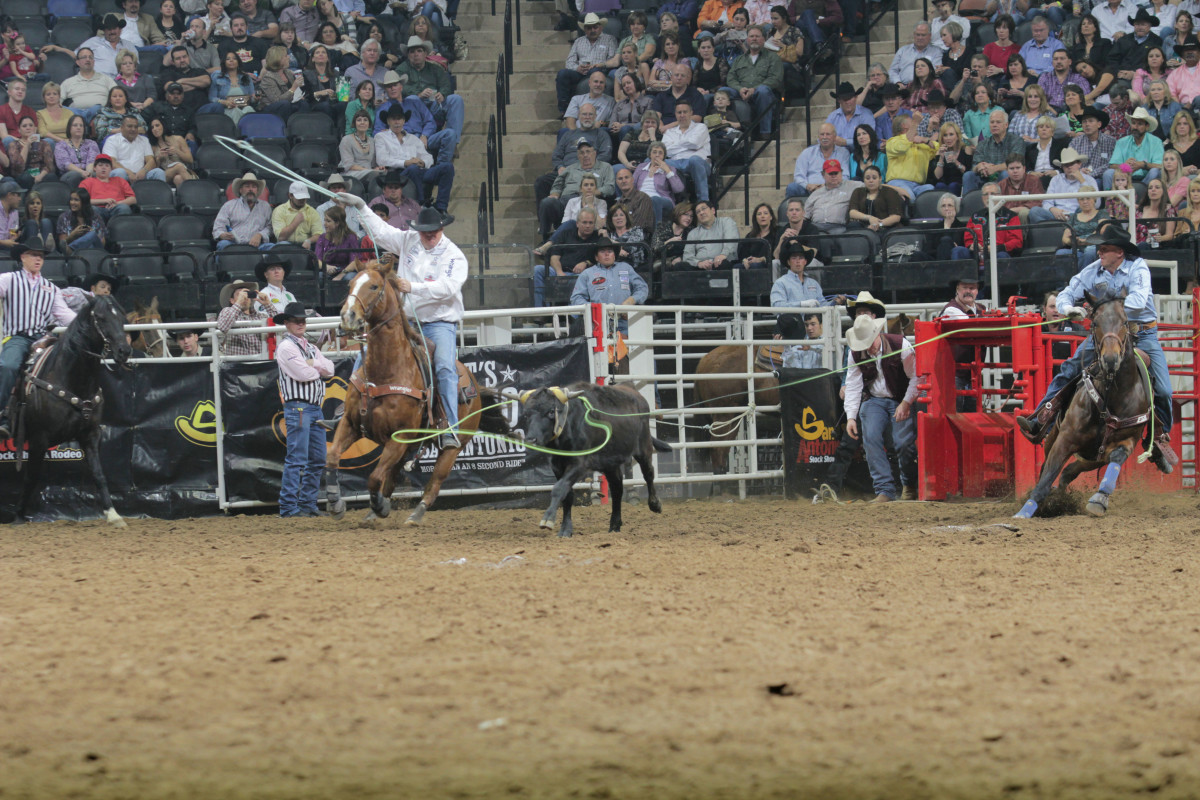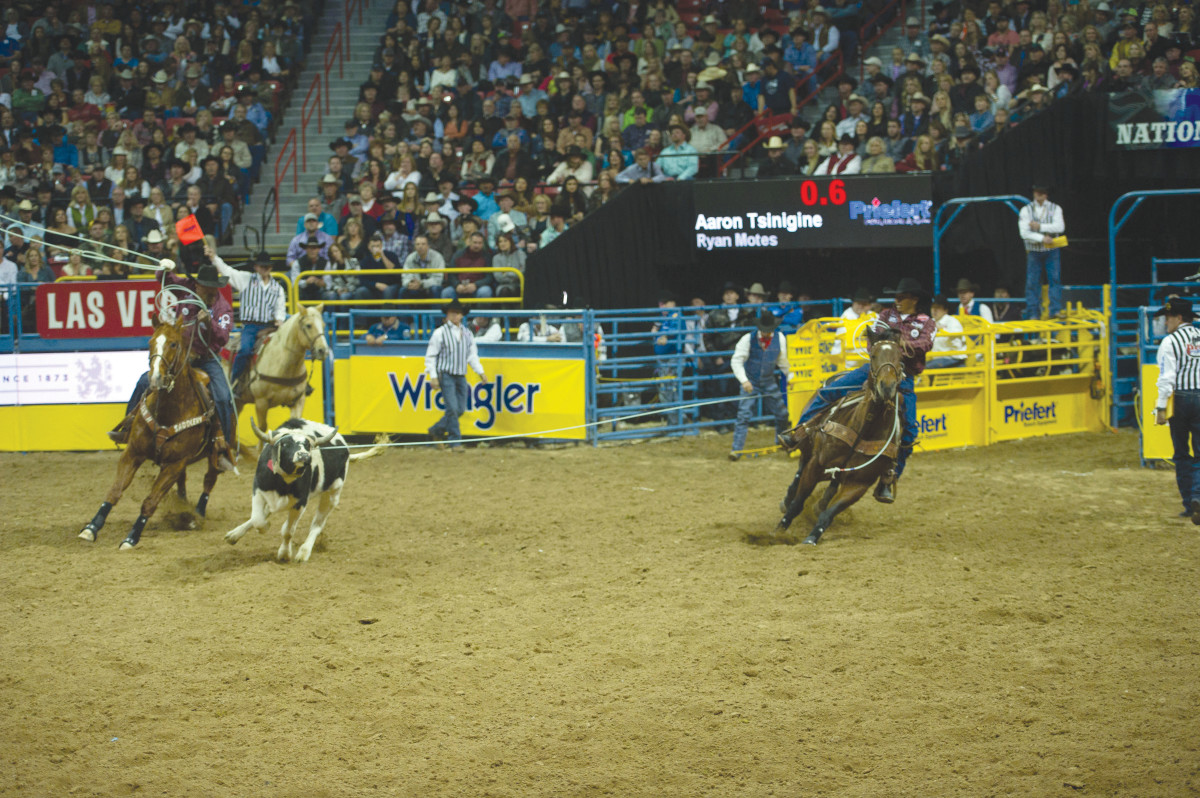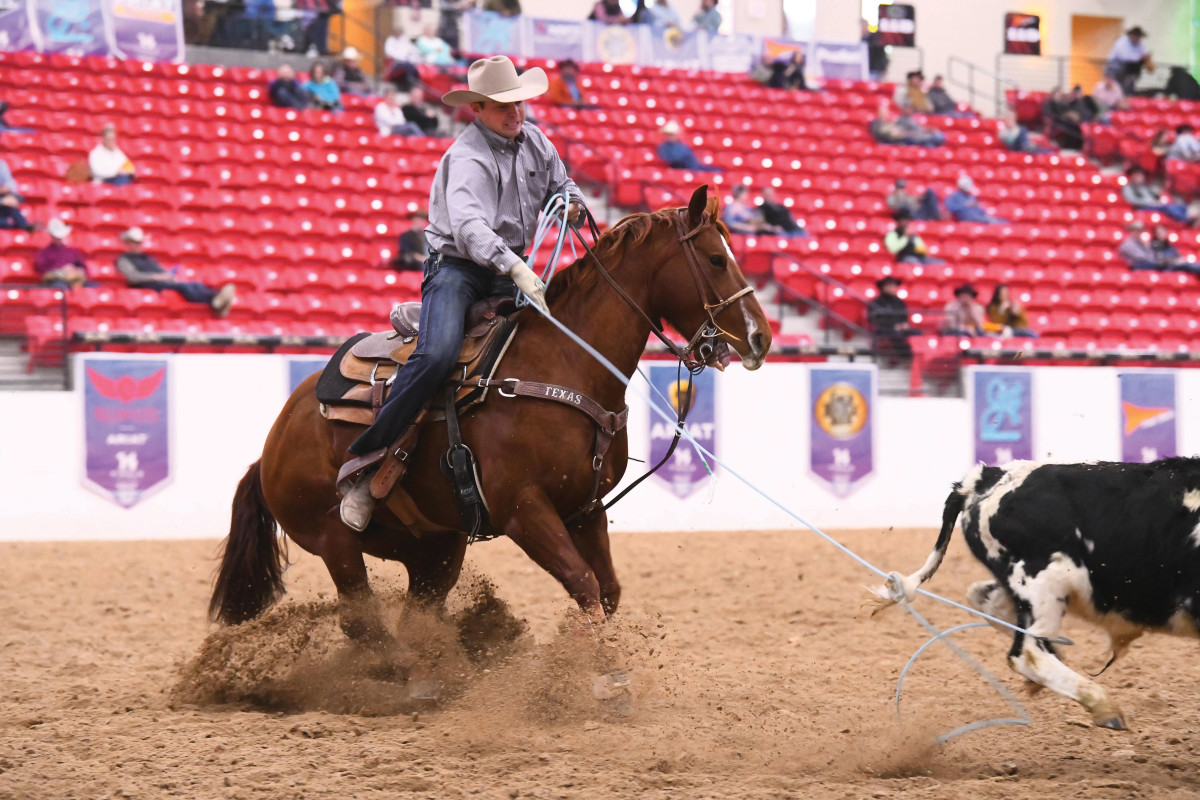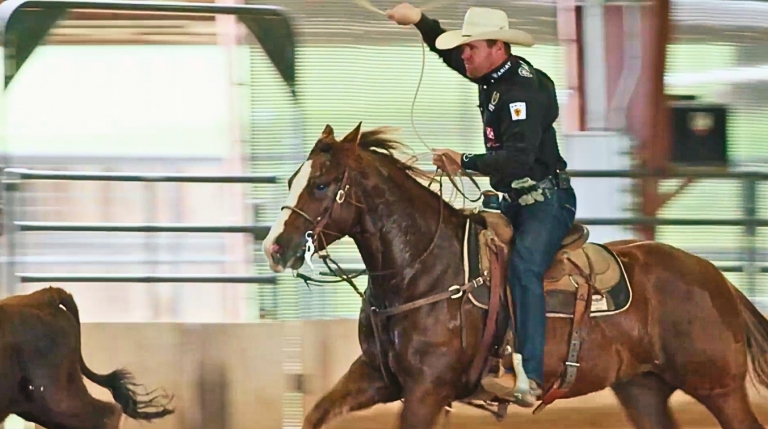Any header who’s chased a Corriente on a hard trajectory to the right fence knows that it’s akin to driving a golf ball out of a sand trap or casting a fishing line through pure moss. It’s maddening. It shouldn’t happen. It fries patience and sucks the joy out of “sticking.” Trying to snap on a head loop while the steer’s right horn is dragging along a fence rail will kill a buzz every time.
By the same token, any heeler who’s tried to haze only to become too high in the corner or too tight to catch two feet knows it’s akin to being forced to throw the football on fourth and one, or roping with one hand behind your back. It’s an anxiety-provoking confidence-killer. It sucks the joy out of setting one down on the first or second hop.
So what’s the answer? Pretend this isn’t a team event? No. Read on for insights on how to help your partner without hurting yourself.

Courtesy Cowboy Images
Good hazing is an art. It’s not easy, but definitely worth it. Consider the setup at the Greeley Stampede or even the BFI, with long scores and fast cattle, says World Champion Heeler Jhett Johnson.
“You can take the exact same steer and, if a heeler can step out and hold him or get him in that left lead, he’s decent,” he said. “But run him back up the alley and let him get to the right, and he’ll haul butt.”
Johnson taught his son, Carson, that your first consideration in hazing is the preference of your header. Almost every header on the planet prefers a steer to run 100% straight. But then, there’s World Champion Header Aaron Tsinigine, who prefers his cattle to run to the right.
“I feel like I can ride another stride or two and take a higher-percentage shot and be just as fast as anybody in the roping—and it’s a more controlled run than if a steer is pushed left,” explained “Spinigine.”
That might not be your forte, however, if you weren’t raised roping wild cows in the desert. Tsinigine, who heeled his way to money in last year’s Ariat WSTR Finale XIV #14.5, agrees that the ideal haze in his league is for a heeler to get up there and hold a steer straight for his partner. To do that, you’ve got to be riding a fast horse that will also rate off when that steer turns.
Clearly, keeping your steer straight as a heeler means you’re more likely to get to throw your rope and more likely to have separation in the corner. So why is it so hard?
For one thing, heelers can’t see the steer’s head through the chute help, so scoring is trickier that way. Plus, many producers set the stripping chute off to the right—and some even point their lead chute toward the right fence. What’s more? Increasing use of heeler barriers.
“In Arizona, most all the jackpots are using World Series barriers so, as a heeler, you simply cannot get a better start than your header,” said four-time NFR header Rube Woolsey, who split $70,000 heeling in the #12.5 at Finale XIV. “It’s created even more of a need for a heel horse that can run.”
Personally, Johnson doesn’t think heeling barriers should exist.
“I always thought, if you’re a good enough horseman and good enough at reading cattle to manipulate a steer during a run, then you should have an advantage,” he said. “Those heeler barriers were first used because guys were ruining cattle by jumping out and shoving them left. But nobody does that anymore. Nothing takes longer than a steer going straight left. Think about the NFR, where the goal is to be fast. Those steers never go left.”

HUbbell Rodeo Photos
Do it early
The biggest key to a good haze, they all agree, is to get the absolute best start possible. The best haze is an early haze.
“If you can pick those steers up just out of the chute and let them see you, you’ll still have time to get into your position for the corner,” said Woolsey, who instructs team ropers full time. “You help that steer choose the line you want him to choose. A lot of lower-numbered heelers haze too late. If you try to haze as the header is catching up, you’re gaining speed as the head rope goes on and you’ll have too much speed to make the turn.”
Britt Ellerman was taught that very thing by his dad, Jay Ellerman, a five-time NFR team roper who’s been coaching for 30 years. Then, he heard the same advice from an eight-time World Champ and Hall-of-Famer. The bottom line is that once a steer picks a direction, it’s not easy to change it. Plus, if you’re late, your header will end up pushing the steer right.
“When I lived at Rich Skelton’s, I heard from him all the time that he leaves with the steer and tries to get up into that position from the very start,” said Ellerman, a 7.5 on both ends who often wins World Series money heeling for his mother and sister. “You have to do your hazing right away.”
Johnson thinks the ideal haze is encouraging the steer to barely get into the left lead. He has another reason to haze early.
“The faster you come into the steer’s vision, the more dramatic the steer’s reaction,” he said. “If you can leave with the steer, and you’re at your spot and the steer is comfortable with you, just stay there.”
Whereas, if you blow up on a steer, it’ll have the same effect as if you stepped out in front of one or “ambushed” your header, Johnson says. Nobody really does that anymore.
“Straight is perfect,” he said. “It’s damn hard to keep a steer straight. If you’re giving him enough air to go straight, then if he wants to get to the right, he can. But you have to give him enough freedom to not shove him left.”
The other strategy they all agree on? Keep the steer’s route consistent. If you overdid the haze and your steer is headed left, keep him headed left. Please. Johnson says allowing one to go back to the right at that point will add four or five seconds to your run. Or, if you got a late start and the steer is headed right, back off and let your header try to clean it up.

Jennings Photography
Contingency strategies
In fact, it pays to know how to handle a steer that won’t take a haze or just didn’t get one. As a header, if you see steers veering right or know you drew a non-hazing partner, Ellerman suggests breaking slightly to the right of center out of the box. Ellerman, who also trains horses, is partnered with Dale Martin at Texas Saddlery and runs a full-service marketing firm, has another suggestion for heading right-leaded steers: width.
“If, as a header, you run narrow to a steer on the fence and have to push the tip of your rope past the right horn, your odds of hitting the fence are higher,” he said. “Width helps your handle, helps your head horse, and gives you forgiveness when roping a steer off the fence.”
Hopefully, your heeler is patiently picking up his horse behind the steer and waiting, he adds.
“If, as a heeler, you keep trying to haze while getting cut off on the fence, you’ll be too close to the steer when it does turn, and might even interfere with your header,” he added. “When the head rope goes on and the header starts to turn, you almost need to wait one more jump before you start the turn, or you’ll end up too close. You don’t want to cut the corner and be forced to wait to heel the steer as it moves away from you.”
Ellerman says Trey Yates is one of the best he’s ever seen at being patient in the corner when steers go to the right fence. Woolsey also says a heeler in this situation needs truckloads of patience.
“If partners end up hitting ropes, it’s the heeler’s fault 100% of the time,” he said. “You cannot be in the header’s space.”
He also feels the same about positioning when a steer comes off the right fence.
“You have to let the header turn the steer without you,” Woolsey added. “Then, come to him and you’ll know where he’s going to be. When a steer pinches you off, you lose that lateral distance like you’d have in the middle of the arena, when you’re 8 or 10 feet out to the right and can turn in without being on top of the steer. From the fence, you’ve lost that spacing. So you have to wait and let the header re-create it.”
Because, let’s face it, he says, heelers tend to leg up or miss whenever they get too tight—including him. And top ropers agree that, not only do you need a heel horse quick enough to lay the barrier back and haze a little, but one that won’t try to cut your corner if you get pinched off to the right.
“If the steer steps right and your horse is barging into the turn, it’s harder to catch two feet because you’re too close, too fast,” said Ellerman. “If your horse is dragging you into the turn along with the steer, it’s just a bad angle. Now, you’ve got to get separation and heel as the steer jumps away. Now, your horse could end up taking the jerk on his front end and get sore. No, you’ve got to wait a jump before you turn and then push to the steer. That way, you can see the feet faster, take a higher-percentage throw and let your horse stop on his rear end.”
In high-numbered ropings, it takes a speed-demon heel horse to outrun the head horse and even the head rope. But, ironically, trying to haze in lower-numbered ropings on slow steers makes it easy to get too high and be in a bad spot. It takes practice—and adhering to the guidelines these money-winning ropers suggest. One of them, 7.5 Louisiana native Mike White, has had a stellar season and beautifully sums up the tricky art of hazing well.
“You can make your header look like a hero but set yourself up for failure if you overcompensate in the haze,” he said. “There’s such a fine line of where you’ve got to be to get it done.”











